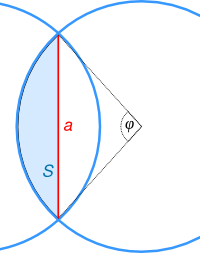
Supplementary Material for Our Paper
Multi-Class (Anisotropic) Electrostatic Halftoning
Home
About Us
People
Teaching
Research
Publications
Awards
Links
Contact
Internal
Multi-Class (Anisotropic) Electrostatic Halftoning
Deviation of Tonemapping Operator
Using our basic halftoning algorithm, the total area of all dots
inside a certain region equals the (scaled) sum of the grey values of
that region. In very dark image regions, however, the dots will
overlap. Thus, these regions are rendered brighter than they should
be. On this page, we derive the equations necessary to compute the
tonemapping operator that should be applied before halftoning to
account for this overlap.
First, we let us analyse how large the overlapping regions are. For
this, we assume that the particles are aligned in an energetically
optimal honeycomb pattern in an area of constant grey value. We note
that overlaps occur only if the circular disc that represents a
particle is larger than the incircle of the corresponding
hexagons. Using the notation from the images shown below, this is the
case if
![]() . If it equals the
circumcircle, the area is rendered in a fully black tone.
. If it equals the
circumcircle, the area is rendered in a fully black tone.


Illustration of the identifiers used on this page.
Blue: Particles forming an energetically optimal honeycomb pattern. Black: Underlying hexagons.
Left: Overlap of particles in a honeycomb pattern. Right: Zoom on one overlap area.
First of all, let us compute the grey value corresponding to the borderline
case
![]() . This is done by computing the coverage in this
situation: We consider the triangle between the centres of three neighbouring
circles and denote its height by
. This is done by computing the coverage in this
situation: We consider the triangle between the centres of three neighbouring
circles and denote its height by ![]() .
Then, its areas is given by
.
Then, its areas is given by
![]() .
Within this triangle, there are three sectors of
.
Within this triangle, there are three sectors of ![]() the
area of a circle, each. The coverage in this case is thus given by:
the
area of a circle, each. The coverage in this case is thus given by:
 |
(1) |
Consequently, above a grey value of
![]() , the circles do not overlap.
, the circles do not overlap.
In the interesting case
![]() , we can express the circular segment
, we can express the circular segment ![]() cut off by
cut off by ![]() as
the difference between the circular sector spanned by
as
the difference between the circular sector spanned by ![]() and the
triangle, i.e.
and the
triangle, i.e.
Since
we can write
and use (4) to rewrite the second term of (2) to obtain
Moreover, we also know that
Combining (3) and (6) results in
 |
(7) | |||
 |
(8) |
Hence, we can also rewrite the first term of (5) and obtain
Let us now express the total overlap ![]() relative to the area of one circle,
and call this the relative loss
relative to the area of one circle,
and call this the relative loss ![]() .
.
 |
 |
(10) |
 |
(11) |
Note that we substitute
![]() . This makes sense since
. This makes sense since
![]() is a free parameter and
is a free parameter and
![]() depends on
depends on ![]() and on the grey
value of the image. The ratio
and on the grey
value of the image. The ratio ![]() thus allows us to regard the problem
independent of the scale, i.e. the absolute error.
thus allows us to regard the problem
independent of the scale, i.e. the absolute error.
Let us forget the loss for a moment and consider the case
![]() in which the rendering works as expected. Here, we obtain the
grey value
in which the rendering works as expected. Here, we obtain the
grey value ![]() as the quotient of the area of the circular disc and the
hexagon it covers:
as the quotient of the area of the circular disc and the
hexagon it covers:
 |
 |
(12) |
 |
(13) | |
 |
(14) |
If the rendering worked well in dark areas, we would also expect such ![]() in
these cases. In other words, the relative loss
in
these cases. In other words, the relative loss ![]() just describes the
deviation of the true grey value
just describes the
deviation of the true grey value ![]() from the desired grey value
from the desired grey value ![]() . The
relative remainder
. The
relative remainder ![]() thus denotes the fraction of the area that is still
rendered. Since the area and the grey value depend linearly on each other,
we can express
thus denotes the fraction of the area that is still
rendered. Since the area and the grey value depend linearly on each other,
we can express ![]() as
as
At this point, we can switch the roles of action and reaction: Considering a
certain grey value ![]() shall be obtained, which grey value
shall be obtained, which grey value ![]() would we need
to sample? Since (15) depends only on
would we need
to sample? Since (15) depends only on ![]() and
and ![]() , we can solve it numerically for
, we can solve it numerically for ![]() assuming a desired
assuming a desired ![]() . Since
the function is not monotonic, we can use that we are only interested in
. Since
the function is not monotonic, we can use that we are only interested in
| (16) | |||||||
 |
(17) | ||||||
 |
(18) |
Finally, we use ![]() in (14) to obtain
in (14) to obtain
![]() .
To finish this derivation, let us check the global mass preservation
of the process given that a tonemapping as explained in the paper is
applied. Regions with a grey value below
.
To finish this derivation, let us check the global mass preservation
of the process given that a tonemapping as explained in the paper is
applied. Regions with a grey value below
![]() are rendered correctly, since
are rendered correctly, since ![]() . Above this
threshold, the grey value preservation follows by construction
from (14)
and (15).
. Above this
threshold, the grey value preservation follows by construction
from (14)
and (15).
< Novelties Main Page Tonemapping operator for 8-bit values >
MIA Group
©2001-2023
The author is not
responsible for
the content of
external pages.
Imprint -
Data protection






